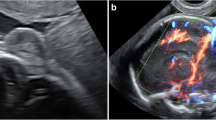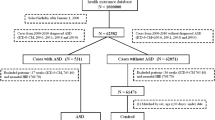Abstract
Heretofore most studies dealing with the association between perinatal complications and autism have used a normal comparison group. In this study obstetrical records of 59 autistic children were compared to those of 28 nonautistic children whose intelligence has a similar range and distribution as the autistic sample. Using an optimality score to reflect number of obstetrical complications, we found that the nonautistic controls experienced less optimal conditions than the autistic sample. Abnormal presentation at birth is the only factor that occurred more frequently for the autistic sample than control sample.
Similar content being viewed by others
References
Broman, S., Nichols P., & Kennedy, W. (1975).Preschool IQ: prenatal and developmental correlates. Hillsdale, NJ: Erlbaum.
Coleman, M., & Gillberg, C. (1986).The biology of the autistic syndromes. New York: Praeger.
Costeff, H., Cohen, B., Weller, L., & Kleckner, H. (1981). Pathogenic factors in idiopathic mental retardation.Developmental Medicine and Child Neurology, 23, 484–493.
Deykin, E., & MacMahon, G. (1980). Pregnancy delivery and neonatal complications among autistic children.American Journal of Diseases of Children, 134, 860–864.
Finegan, J. A., & Quarrington, B. (1979). Pre-, peri- and neonatal factors and infantile autism.Journal of Child Psychology and Psychiatry, 20, 119–128.
Gillberg, C., & Gillberg, I. C. (1983). Infantile autism: A total population study of reduced optimality in the pre-, peri-, and neonatal period.Journal of Autism and Developmental Disorders, 13, 153–166.
Knobloch, H., & Pasamanick, B. (1975). Some etiologic and prognostic factors in early infantile autism and psychosis.Journal of Pediatrics, 55, 182–191.
Kolvin, I., Ounsted, C., & Roth, M. (1971). Studies in the childhood psychosis: Cerebral dysfunction and childhood psychoses.British Journal of Psychiatry, 118, 407–414.
Levy, S. (1978).Developmental history for the diagnosis of autism. Bloomington, IN: Developmental Training Center.
Lobascher, M. E., Kingerlee, P. E., & Gubbay, S. S. (1970). Childhood autism: An investigation of aetiological factors in twenty-five cases.British Journal of Psychiatry, 117, 525–529.
Lord, C., & Schopler, E. (1985). Differences in sex ratios in autism as a function of measured intelligence.Journal of Autism and Developmental Disorders, 15, 185–193.
Mason-Brothers, A., Ritvo, E., Guze, B., Mo, A., Freeman, B., Funderburk, S., & Schroth, P. (1987). Pre-, peri-, and postnatal factors in 181 autistic patients from single and multiple incidence families.Journal of the American Academy of Child Adolescent Psychiatry, 26, 39–42.
Mullen, E. (1977).The psychological stimulus/response test, East Providence, RI: Meeting Street School.
Rutt, C. N., & Offord, D. R. (1971). Prenatal and perinatal complications in childhood schizophrenia and their siblings.Journal of Nervous Mental Disorders, 152, 324–331.
Rutter, M. (1979). Diagnosis and defintion. In M. Rutter & E. Schopler (Eds.),Autism: A reappraisal of concepts and treatment. New York: Plenum Press.
Rutter, M. (1983). Cognitive deficits in the pathogenesis of autism.Journal of Child Psychology and Psychiatry, 24, 513–531.
Rutter, M., & Lockyer, L. (1967). A five to fifteen-year follow-up study of infantile psychosis: I. Description of the sample.British Journal of Psychiatry, 113, 1169–1182.
Schopler, M., & Reichler, R. (1979).The psychoeducational profile (Vol. 1). Austin, TX: Pro-Ed.
Torrey, E., Hersh, S., & McCabe, K. (1975). Early childhood psychosis and bleeding during pregnancy.Journal of Autism and Childhood Schizophrenia, 5, 287–297.
Whittam, H., Simon, G. B., & Mittler, P. J. (1966). The early development of psychotic children and their sibs.Developmental Medicine and Child Neurology, 8, 552–560.
Yule, W. (1979). What are the “correct controls”? In M. Rutter & E. Schopler (Eds.),Autism: A reappraisal of concepts and treatment. New York: Plenum Press.
Author information
Authors and Affiliations
Additional information
We are grateful to our friends and colleagues, Sam Odom and Arthur Koch, for assistance with the statistical treatment of the data. We also acknowlege the support of Henry Schroeder, Director of the Institute for the Study of Developmental Disabilities.
Rights and permissions
About this article
Cite this article
Levy, S., Zoltak, B. & Saelens, T. A comparison of obstetrical records of autistic and nonautistic referrals for psychoeducational evaluations. J Autism Dev Disord 18, 573–581 (1988). https://doi.org/10.1007/BF02211875
Issue Date:
DOI: https://doi.org/10.1007/BF02211875




